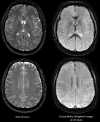Acute and Evolving MRI of High-Altitude Cerebral Edema: Microbleeds, Edema, and Pathophysiology
- PMID: 30679208
- PMCID: PMC7028681
- DOI: 10.3174/ajnr.A5897
Acute and Evolving MRI of High-Altitude Cerebral Edema: Microbleeds, Edema, and Pathophysiology
Abstract
MR imaging of high-altitude cerebral edema shows reversible WM edema, especially in the corpus callosum and subcortical WM. Recent studies have revealed hemosiderin deposition in WM long after high-altitude cerebral edema has resolved, providing a high-altitude cerebral edema "footprint." We wished to determine whether these microbleeds are present acutely and also describe the evolution of all MR imaging findings. In 8 patients with severe high-altitude cerebral edema, we obtained 26 studies: 18 with 3T and 8 with 1.5T scanners, during the acute stage, recovery, and follow-up in 7 patients and acutely in 1 patient. Imaging confirmed reversible cytotoxic and vasogenic WM edema that unexpectedly worsened the first week during clinical improvement before resolving. The 3T SWI, but not 1.5T imaging, showed extensive microbleeds extending beyond areas of edema seen acutely, which persisted and with time coalesced. These findings support cytotoxic and vasogenic edema leading to capillary failure/leakage in the pathophysiology of high-altitude cerebral edema and provide imaging correlation to the clinical course.
© 2019 by American Journal of Neuroradiology.
Figures






Similar articles
-
An Observational Cerebral Magnetic Resonance Imaging Study Following 7 Days at 4554 m.High Alt Med Biol. 2019 Dec;20(4):407-416. doi: 10.1089/ham.2019.0056. Epub 2019 Nov 14. High Alt Med Biol. 2019. PMID: 31724893
-
Improved Neuroimaging Findings and Cognitive Function in a Case of High-altitude Cerebral Edema.Intern Med. 2021 Apr 15;60(8):1299-1302. doi: 10.2169/internalmedicine.5747-20. Epub 2020 Nov 23. Intern Med. 2021. PMID: 33229804 Free PMC article.
-
[Cerebral vasoreactivity in high-altitude cerebral edema].Neurologia. 2008 Jan-Feb;23(1):65-8. Neurologia. 2008. PMID: 17602334 Spanish.
-
Emerging concepts in acute mountain sickness and high-altitude cerebral edema: from the molecular to the morphological.Cell Mol Life Sci. 2009 Nov;66(22):3583-94. doi: 10.1007/s00018-009-0145-9. Epub 2009 Sep 10. Cell Mol Life Sci. 2009. PMID: 19763397 Free PMC article. Review.
-
High altitude cerebral edema and acute mountain sickness. A pathophysiology update.Adv Exp Med Biol. 1999;474:23-45. doi: 10.1007/978-1-4615-4711-2_2. Adv Exp Med Biol. 1999. PMID: 10634991 Review.
Cited by
-
Non-Invasive Monitoring of Cerebral Edema Using Ultrasonic Echo Signal Features and Machine Learning.Brain Sci. 2024 Nov 23;14(12):1175. doi: 10.3390/brainsci14121175. Brain Sci. 2024. PMID: 39766374 Free PMC article.
-
Critical illness-associated cerebral microbleeds involving the corpus callosum following cardiac arrest: A case report.Medicine (Baltimore). 2024 Aug 9;103(32):e39273. doi: 10.1097/MD.0000000000039273. Medicine (Baltimore). 2024. PMID: 39121333 Free PMC article.
-
Increase in Ventricle Size and the Evolution of White Matter Changes on Serial Imaging in Critically Ill Patients with COVID-19.Neurocrit Care. 2021 Oct;35(2):491-500. doi: 10.1007/s12028-021-01207-2. Epub 2021 Mar 5. Neurocrit Care. 2021. PMID: 33674942 Free PMC article.
-
Atypical High-Altitude Cerebral Edema Presentation at an Altitude of Less Than 3000 Meters Elevation: A Case Report.Open Access Emerg Med. 2022 Mar 29;14:119-122. doi: 10.2147/OAEM.S336951. eCollection 2022. Open Access Emerg Med. 2022. PMID: 35378869 Free PMC article.
-
Diabetic ketoacidosis and cerebral edema: a rare case of infarct-like MRI findings in a pediatric patient.Ann Med Surg (Lond). 2025 May 12;87(6):3963-3968. doi: 10.1097/MS9.0000000000003332. eCollection 2025 Jun. Ann Med Surg (Lond). 2025. PMID: 40486604 Free PMC article.
References
MeSH terms
LinkOut - more resources
Full Text Sources
